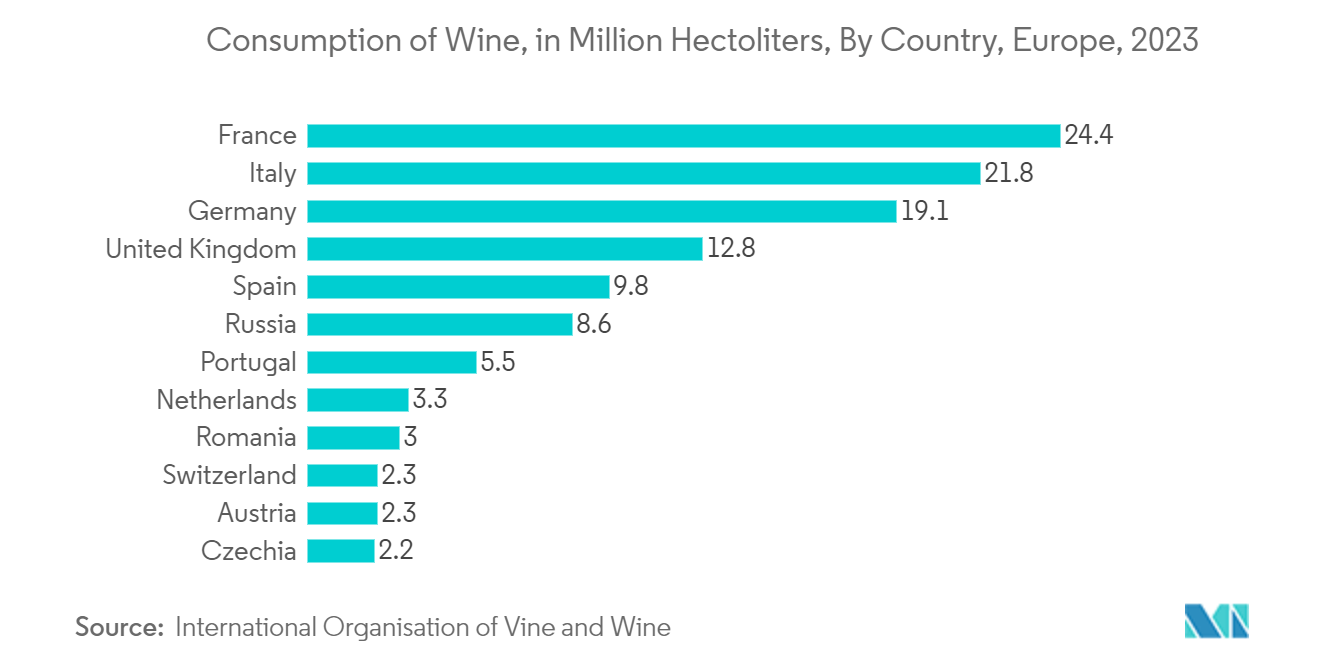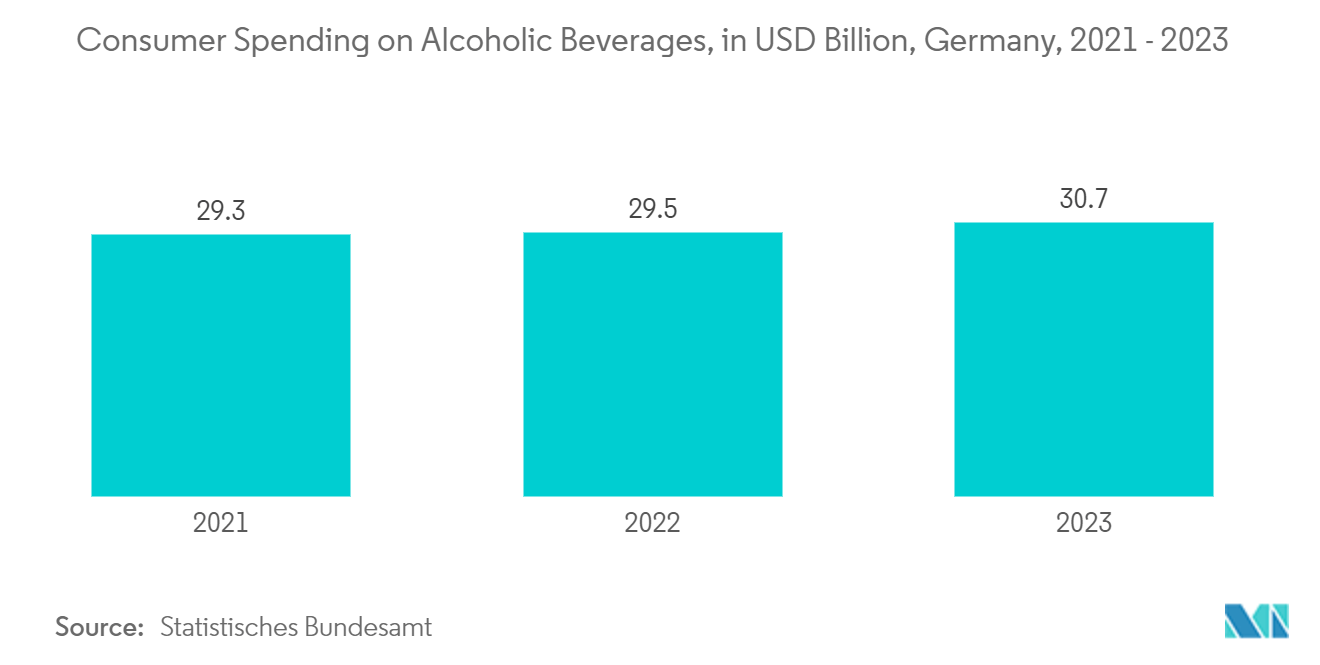Market Trends of Europe Glass Bottles And Containers Industry
Beverage Industry to Hold a Significant Market Share
- Europe hosts several of the world's leading wine-producing nations, including France, Italy, Spain, and Germany, where glass bottles remain the dominant packaging choice for wine. Glass is widely regarded as the optimal material for maintaining wine's flavour, aroma, and quality, and it is closely associated with premium products. The wine industry continues to be a primary driver of glass container demand in Europe, with glass packaging accounting for over 80% of wine packaging in certain countries.
- France remained one of the leading wine consumers among European countries, with consumption reaching approximately 24.4 million hectoliters in 2023. This high level of consumption reflects France's deep-rooted wine culture and its significance in daily life and social gatherings. According to the International Organisation of Vine and Wine, the United Kingdom consumed about 12.8 million hectoliters. The UK's wine consumption has been steadily growing, influenced by changing consumer preferences and an increasing appreciation for wine.
- This trend in wine consumption across Europe indicates continued demand for glass bottles as packaging materials. Glass bottles remain the preferred packaging option for wine due to their ability to preserve flavour, extend shelf life, and provide a premium aesthetic appeal to consumers. The sustained growth in wine consumption in these critical European markets suggests a parallel increase in the demand for high-quality glass packaging solutions in the beverage industry.
- The glass container beverage market shows strength in premium and niche sectors, such as craft beer, organic juices, and high-end spirits. The demand for high-quality, environmentally friendly packaging solutions drives growth in glass container usage for these categories. Craft beer and small-batch beverages contribute significantly to the market for glass packaging. Many craft brewers and small beverage producers choose glass bottles to communicate quality, tradition, and environmental responsibility to their customers.
- Despite the dominance of plastic and aluminium cans, glass bottles remain in niche segments of the soft drink market, including premium sodas, organic beverages, and craft soft drinks. The increasing popularity of natural, organic, and health-focused beverage brands has contributed to using glass as a sustainable packaging option. Fresh juices, particularly cold-pressed and organic varieties, are frequently packaged in glass due to their ability to preserve product quality and taste.
- Europe shows an increasing preference for environmentally friendly packaging, driven by growing consumer awareness of plastic pollution and stricter regulations on single-use plastics. Being highly recyclable and indefinitely reusable without quality loss, glass appeals to environmentally conscious consumers in beverage packaging.
- This shift towards sustainable options influences manufacturers and retailers to adopt glass packaging for various products, including beverages. Glass's recyclability and reusability align with circular economy principles, further enhancing its appeal in the European market. Additionally, glass packaging's ability to preserve product quality and extend shelf life contributes to its growing popularity among consumers and producers in the region.

Germany to Hold a Significant Market Share
- Germany represents a significant market for glass containers in Europe. Its robust industrial sector, high consumption of packaged goods, and increasing emphasis on sustainability support this market. The food and beverage, cosmetic, and pharmaceutical industries primarily drive the demand for glass containers in Germany.
- The non-alcoholic beverage segment, especially in premium and organic categories, also embraces glass packaging for products like juices and health drinks. Germany's strong beer heritage, preference for glass in various beverage sectors, and consumer inclination towards safe, inert packaging materials collectively contribute to the robust demand for glass containers in the country's beverage industry.
- According to Statistisches Bundesamt, consumer spending on alcoholic beverages in Germany has steadily increased from 2021 to 2023. In 2021, spending reached USD 29.3 billion, followed by a slight rise to USD 29.5 billion in 2022. By 2023, this figure grew to USD 30.7 billion, reflecting a consistent upward trend in the country's expenditure on alcoholic drinks over the past three years.
- Germany also maintains one of the world's highest glass recycling rates, with over 90% of glass bottles being recycled. As environmental awareness grows, German consumers and companies increasingly choose glass as a sustainable packaging material. Glass is widely recognized as eco-friendly due to its 100% recyclability without quality loss. This has led to a rising preference for glass containers, particularly in light of German packaging waste laws and Extended Producer Responsibility (EPR) regulations promoting recyclable materials.
- The country participates in the export of container glass products. According to the International Trade Center, Germany's export volume increased significantly from 1,094,706 tons in 2021 to 1,494,488 tons in 2022, a 36.4% rise. This increase suggests heightened international demand for German products. Factors contributing to this growth may include post-pandemic economic recovery, increased global trade, or specific industry booms in sectors like automotive, chemicals, machinery, or consumer goods.
- In 2023, export volume decreased slightly to 1,205,642 tons, a 19.4% reduction from the 2022 peak. This decline may be attributed to supply chain disruptions, global economic challenges, or changing demand patterns in critical markets. Factors such as commodity price fluctuations, shifts in international demand, or geopolitical tensions, including the Ukraine conflict, could have influenced Germany's export performance in 2023.


